What would your future-you have to say to you?
The no-pants guide to spending, saving, and thriving in the real world.
What would your future-you have to say to you?
I’ve spend the last 10 days at home with my two youngest kids. It’s been a lot of fun. It’s amazing watching them interact with each other and seeing how their imaginations works. It’s also been a helpful reminder that, if I don’t turn on the TV, they will happily find something else to do.
This month, I am trying to establish the Slow Carb Diet as a habit. At the end of the month, I’ll see what the results were and decide if it’s worth continuing. For those who don’t know, the Slow Carb Diet involves cutting out potatoes, rice, flour, sugar, and dairy in all their forms. My meals consist of 40% proteins, 30% vegetables, and 30% legumes(beans or lentils). There is no calorie counting, just some specific rules, accompanied by a timed supplement regimen and some timed exercises to manipulate my metabolism. The supplements are NOT effedrin-based diet pills, or, in fact, uppers of any kind. There is also a weekly cheat day, to cut the impulse to cheat and to avoid letting my body go into famine mode.
I’m measuring two metrics, my weight and the total inches of my belly, waist, biceps, and thighs. Between the two, I should have an accurate assessment of my progress.
Weight: I have lost 11 pounds since January 2nd. This is crazy. At least part of this has to be due to the natural swing of up to 5 pounds from day to day, and part of it is due to the fact that I was wearing jeans when I weighed in the first time and cotton pajamas this morning. From now on, this is going to be the first thing I do on Saturday mornings, so everything is as consistent as possible. Another factor is that I’ve cut most of the crap out of my diet for a week. My body has been flushing garbage. But dang! 11 pounds in a week. I’m a bit excited.
Total Inches: I have lost 5.5 inches in the same time frame. This is proof that it’s not just water that I lost, which is where first, dramatic losses usually originate in a diet.
The loss seems a little bit nuts. Here’s hoping it stays consistent.
Your retirement account shouldn’t be an optional investment. Do you know how to maximize retirement savings?
I’m a big fan of making extra money. Money Crashers lists 6 sites to help you rake in the cash, without needing any special skills.
Unclutterer is giving away three Fujitsu Scansnaps. I want one of these is a way that isn’t quite right.
I’ve been moving to LED lights instead of CFLs for a few years. CFLs make lousy security lights in Minnesota in the winter. They take 5 minutes to get to full brightness when it’s cold. LEDs last forever.
This is where I review the posts I wrote one year ago.
I posted about the difference between bribes and rewards and the problems inherent in trying to buy good behavior.
Lesson 2 of my budget series went live, detailing my monthly bills.
We made some changes to our budget plans that haven’t worked very well. Over the course of the last year, every one of these ideas has either been partially or totally abandoned, but it’s working for us.
How to Complain – The Squeaky Wheel Gets the Grease was included in the Carnival of Personal Finance.
3 Things You Need to Know About Homeowner’s Insurance was included in the Festival of Frugality.
Thank you! If I missed anyone, please let me know.
There are so many ways you can read and interact with this site.
You can subscribe by RSS and get the posts in your favorite news reader. I prefer Google Reader.
You can subscribe by email and get, not only the posts delivered to your inbox, but occasional giveaways and tidbits not available elsewhere.
You can ‘Like’ LRN on Facebook. Facebook gets more use than Google. It can’t hurt to see what you want where you want.
You can follow LRN on Twitter. This comes with some nearly-instant interaction.
You can send me an email, telling me what you liked, what you didn’t like, or what you’d like to see more(or less) of. I promise to reply to any email that isn’t purely spam.
That’s all for today. Have a great weekend!
When you accumulate a certain level of debt, it feels like you’re wading through an eyeball-deep pool of poo, dancing on your tiptoes just to keep breathing. Ask me how I really feel.
It shouldn’t be a surprise that I’m in debt. We have gone over this before. The story isn’t one of my proudest, so I’ve never talked much about how it happened.
Our debt was entirely our fault. We messed up and dug our own poo-pool. There were no major medical bills, no extended unemployment, just a strong consumer urge and an apparent need for instant gratification. Delayed gratification wasn’t a skill I’d considered learning. The idea of it was a thoroughly foreign concept. Why wait when every store we visited offered no payments/no interest for a year? We didn’t give much thought to what would happen when the year was up.
We got married young. We bought our house young. We started our family young. We did all of that over the course of two years, well before we were financially ready. Twenty years old, we had excellent credit and gave our credit reports a workout. Credit was so easy to get. By the time I was 22, we had a total credit limit more than twice our annual income. We fought so hard to keep up with the Joneses. A new pickup, a remodel on our house. Within a month of paying off the truck, I got a significant raise and rushed out to buy a new car.
Every penny that hit the table was caught in a net of lifestyle expansion. I was bouncing on my tiptoes.
Four months into my new car payment, I was laid off. There’s me, hoping for a snorkel. A week later, we found out our son was going to be a big brother. Our pool had developed a tide.
We killed the cable and cut back on everything else and…managed. Money was tight, but we got by. I got a new job, but had we learned any lessons? Of course not. We got a satellite dish, started shopping the way we always had. Times were good, and could never be bad. We had such short memories.
Fast forward a couple of years. Baby #3 is on the way while baby #2 is still in diapers. Daycare was about to double. Daddy started to panic. I built a rudimentary budget and realized there was no way to make ends meet. There just wasn’t enough cash coming in to cover expenses. That’s when I made my first frugal decision: I quit smoking. That cut the expenses right to the level of our income. It was tight, but doable.
There was still one serious problem. Neither one of us could control our impulse shopping. For a time, I was getting packages delivered almost every day. It was never anything expensive, but it was always something. Little things add up quickly.
Last spring, I realized we couldn’t keep going like that. I started looking into bankruptcy. Somehow, we managed to toss ourselves into the deep end of the pool. We had near-perfect credit and no way to maintain it.
While researching bankruptcy, I found our life preserver. We put together a budget. We cut and…it hurt. It’s taken a year, but every bill we have is finally being tracked. We have an emergency fund and we are working towards our savings goals. It hasn’t been an easy year, but we are making progress. We’ve eliminated 15% of our debt and opened out budget to include some “blow money” and an occasional date night. We are always looking for ways to decrease our bottom line and increase the top line. Most important, we are actually working together to keep all of our expenses under control, with no hurt feelings when we remind ourselves to stay on track.
We are finally standing flat-footed, head and shoulders above the poo.
Update: This post has been included in the Carnival of Personal Finance.

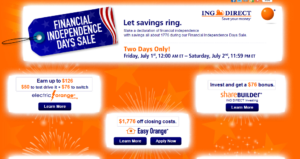
I just got an email from INGDirect. To celebrate Independence Day, they are having a sweet, sweet sale.
You can:
Take advantage of all of that and you’ll get $2054 in cash or discounts.
Seriously, this deal rocks. If you don’t have an INGDirect account, get one. There are no overdraft fees and no monthly fees.
The sale ends tomorrow at midnight, so hurry.

 [Editor: This is a guest post from my good friend Terra. I’ve know her for–jeez, really–20 years. If you’re looking for a staff writer, hit her up. Seriously. She’s good people.]
[Editor: This is a guest post from my good friend Terra. I’ve know her for–jeez, really–20 years. If you’re looking for a staff writer, hit her up. Seriously. She’s good people.]
Who doesn’t want a brighter future for their child? Book store shelves overflow with parenting advice tomes and how-to guides to make “uber-kids”. Eager parents lap up promises to raise their children’s I.Q., increase their chances to get into college, and improve their social skills.
From books to apps to specialized software, there is a dizzying number of products available to help your child grow into the genius you know he or she is.
But what if I told you that the secrets to increasing your child’s likelihood to succeed in life were absolutely free. Simple things you have complete control over. No batteries or special upgrades required. No matter your income, education level, or what country you live in, these deceptively simple tips offer powerful results.
Food connects people. From the dawn of time, our species has gathered around the fire, to break bread and share our stories.
In modern times, our schedule can be crazy (between work, social activities, and, you know, life) so having dinner on the table at 6 o’clock every night is not always possible. However, studies consistently show that having a family meal at least 3 times a week has huge benefits for children (from teenagers being less likely to abuse drugs and alcohol, to increased academic success, to reduced risk of developing eating disorders or becoming obese, the implications are impressive). And it doesn’t have to be dinner, any meal will work. Consistency is the key.
Far from being boring, children find the predictable routine of family meals reassuring, promoting warm, fuzzy feelings of closeness and comfort (though teenagers will never admit it). Whether it’s take-out or made from scratch goodness, nothing says “I care about you” like sharing a meal.
Quality matters here, so remove distractions during meal time (turn off the TV, ban phones) and focus on each other. Take this time to reconnect and talk about your day and ask the kids about theirs. Make this time sacred. It matters that much.
“We need 4 hugs a day for survival. We need 8 hugs a day for maintenance. We need 12 hugs a day for growth.” – Virginia Satir, psychotherapist
Receiving a loving hug feels wonderful. But beyond feeling “nice”, hugs literally have the power to heal us and improve our lives.
Hugs have superpowers. A hug has the power to release a “happiness hormone cocktail” of oxytocin (natural antidepressant, promotes feelings of devotion, trust and bonding), dopamine (intense pleasure), and serotonin (elevates mood, negates pain and sadness) in both the giver and receiver. Bonus, hugs are naturally gluten-free, organic, and have no unpleasant side effects.
To get the most benefits, prolonged hugging is recommended, around 20 seconds. A full-body hug stimulates your nervous system while decreasing feelings of loneliness, combating fear, increasing self-esteem, defusing tension, and showing appreciation. However, this hug fest only works its magic if you’re hugging someone you trust. Since children love to be held and cuddled, this is ideal for family bonding. Not so much with that new client you just landed (awkward…).
How does hugging effect children specifically? Children who aren’t hugged have delays in walking, talking, and reading. Hugging boosts self-esteem; from the time we’re born our family’s touch shows us that we’re loved and special. All of those cuddles we give to our children are imprinted on them at a cellular level and will still be imbedded in their nervous system as adults. Hugs today equal the ability to self-love as adults. That’s an awesome gift.
We all know how important reading aloud to children is, from infants to teenagers. Reading is one of the most important factors affecting the development of a child’s brain. But reading skills are not hardwired into us; we don’t pop out of the womb quoting “Pride and Prejudice”. Reading skills need to be taught and encouraged.
Parents are a child’s first, and most important, teachers. While children can learn from flashcards and workbooks, nothing is more powerful than seeing your passion for reading. Whether you like it or not, your children are learning from your every move. What you find important, they will find important. No pressure! Teaching reading to your child requires attention, focus, and motivation. It also requires access to books, lots and lots of books.
Libraries are a great resource for developing a love of reading in your child. Most have a thoughtfully arranged children’s area offering story-time and other enrichment opportunities. However, nothing beats having a book to call your own, to hold and cherish, until the edges are worn with love.
Having a well-stocked home library, it turns out, matters. A lot. This study found that having a 500-book library was equivalent to having university-educated parents in terms of increasing the level of education their children will attain. That’s pretty powerful. It doesn’t matter if your family is rich or poor, from North America or Asia, if your parents are illiterate or college-educated, what matters is that you have books in your home.
Don’t’ have the space for 500 books? No worries. Having as few as 20 books in the home still has a significant impact on propelling a child to a higher level of education, and the more books you add, the greater the benefit.
Having a variety of books available makes a difference; especially important are reference books, with history and science texts having the greatest benefit.
No money for books? No Excuse! Dolly Parton’s Imagination Library is a great resource for free, high-quality children’s books. When you sign up, your child is mailed a new book each month until the age of five, addressed to them (a very special thing indeed).
I hope these tips empower you to take action. Small changes can have a big impact on your child’s future. Just remember, it’s not the money you make or the tutor you’ve hired or the new app you’ve installed that will catapult your baby Einstein ahead in life. It’s the quiet moments with you at home, eating, hugging, and reading that will carry them through whatever life brings their way.
Are these things you would like to focus on in your family? Do you have simple parenting tips that have made a difference in your child’s life?
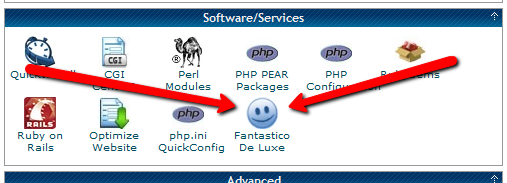
In this installment of the Make Extra Money series, I’m going to show you how to set up a WordPress site. I’m going to show you exactly what settings, plugins, and themes I use. I’m not going to get into writing posts today. That will be next time.
I use WordPress because it makes it easy to develop good-looking sites quickly. You don’t have to know html or any programming. I will be walking through the exact process using Hostgator, but most hosting plans use CPanel, so the instructions will be close. If not, just follow WordPress’s 5 minute installation guide.
Assuming you can follow along with me, log in to your hosting account and find the section of your control panel labeled “Software/Service”. Click “Fantastico De Luxe”.

On the Fantastico screen, click WordPress, then “New Installation”.
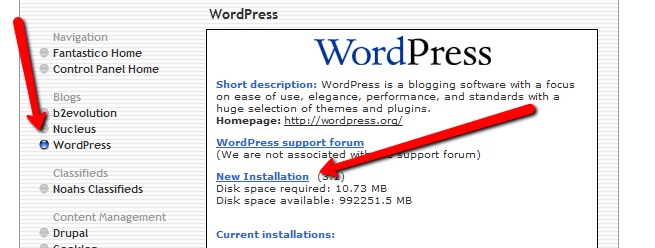
On the next screen, select your domain name, then enter all of the details: admin username, password, site name, and site description. If you’ll remember, I bought the domain http://www.masterweddingplanning.net. I chose the site name of “Master Wedding Planning” and a description of “Everything You Need to Know to Plan Your Wedding”.
Click “install”, then “finish installation”. The final screen will contain a link to the admin page, in this case, masterweddingplanning.net/wp-admin. Go there and log in.
After you log in, if there is a message at the top of the screen telling you to update, do so. Keeping your site updated is the best way to avoid getting hacked. Click “Please update now” then “Update automatically”. Don’t worry about backing up, yet. We haven’t done anything worth saving.
Next, click “Settings” on the left. Under General Settings, put the www in the WordPress and site URLs. Click save, then log back in.
Click Posts, then Categories. Under “Add New Category”, create one called “Misc” and click save.
Click Appearance. This brings you to the themes page. Click “Install Themes” and search for one you like. I normally use Headway, but before I bought that, I used SimpleX almost exclusively. Your goal is to have a simple theme that’s easy to maintain and easy to read. Bells and whistles are a distraction.
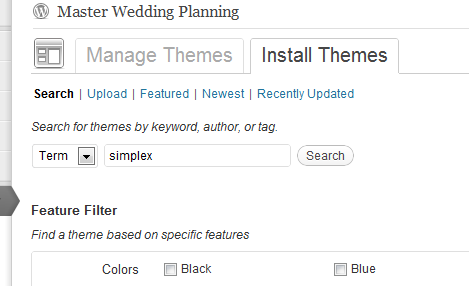
Click “Install”, “Install now”, and “Activate”. You now have a very basic WordPress site.
A plugin is an independent piece of software to make independent bits of WordPress magic happen. To install the perfect set of plugins, click Plugins on the left. Delete “Hello Dolly”, then click “Add new”.
In the search box, enter “plugin central” and click “Search plugins”. Plugin Central should be the first plugin in the list, so click “install”, then “ok”, then “activate plugin”. Congratulations, you’ve just installed your first plugin.
Now, on the left, you’ll see “Plugin Central” under Plugins. Click it. In the Easy Plugin Installation box, copy and paste the following:
All in One SEO Pack Contact Form 7 WordPress Database Backup SEO SearchTerms Tagging 2 WP Super Cache Conditional CAPTCHA for WordPress date exclusion seo WP Policies Pretty Link Lite google xml sitemaps Jetpack by WordPress.com
Click “install”.
On the left, click “Installed Plugins”. On the next screen, click the box next to “Plugins”, then select “Activate” from the dropdown and click apply.
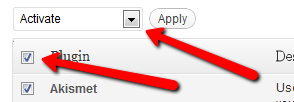
Still under Plugins, click “Akismet Configuration”. Enter your API key and hit “update options”. You probably don’t have one, so click “get your key”.
The only tool I worry about is the backup. It’s super-easy to set up. Click “Tools”, then “Backup”. 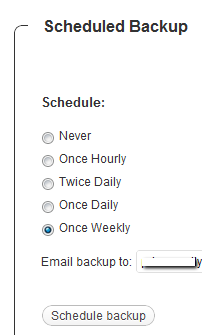
Scroll down to “Schedule Backups”, select weekly, make sure it’s set to a good email address and click “Schedule Backup”. I only save weekly because we won’t be adding daily content. Weekly is safe enough, without filling up your email inbox.
There are a lot of settings we’re going to set. This is going to make the site more usable and help the search engines find your site. We’re going to go right down the list. If you see a section that I don’t mention, it’s because the defaults are good enough.
Set the Default Post Category to “Misc”.
Visit this page and copy the entire list into “Update Service” box. This will make the site ping a few dozen services every time you publish a post. It’s a fast way to get each post indexed by Google.
Click “Save Changes”.
Uncheck everything under “Email me whenever…” and hit save. This lets people submit comments, without actually posting the comments or emailing me when they do so. Every once in a while, I go manually approve the comments, but I don’t make it a priority.
Select “Custom structure” and enter this: /%postname%/
Click save.
Set the status to “Enabled”, then fill out the site title and description. Keep the description to about 160 characters. This is what builds the blurb that shows up by the link when you site shows up in Google’s results.
Check the boxes for “Use categories for META keywords” and “Use noindex for tag archives”.
Click “Update Options”.
Check the boxes to remove each of the dates and set the alt text to “purpose” or something. This will suppress the date so your posts won’t look obsolete.
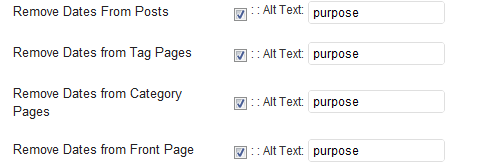
This plugin reinforces the searches that bring people to your site. It’s kind of neat. Skip the registration, accept the defaults and hit save.
Scroll to the bottom and click import. We’ll come back to this.
Select “Caching On” and hit save.
Across the top of the screen should be a giant banner telling you to connect to WordPress.com and set up Jetpack. You’ll need an account on WordPress.com, so go there and set one up. After authorizing the site, you’ll be brought back to the Jetpack configuration screen. Click “Configure” under “WordPress.com Stats”. Take the defaults and hit save.
On the contact configuration page, copy the code in the top section. You’ll need this in a moment.
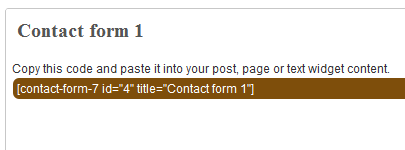
Now, we going to create a couple of static pages. On the left, click “Pages”, then “Add new”.
Name the first page “Contact” and put the contact form code in the body of the page. Hit publish.
Under Appearance, click “Menu”. Enter a menu name and hit save.
Then, under “Pages”, click the box next to “Contact”, “Disclaimer”, and any other policies you’d like to display. Hit save.
Also under Appearance, click “Widgets”. This is where you’ll select what will display in the sidebar. All you have to do is drag the boxes you want from the middle of the page to the widget bar on the right. I recommend Text, Search, Recent Posts, Popular Search Terms and Tag Cloud. In the text box, just put some placeholder text in it, like “Product will go here”. We’ll address this next time.
We’re not going to worry about getting posts in place, yet. That will be the next installment. However, the steps in the next installment could take 2 weeks to implement, and we want Google to start paying attention now. To make that happen, we need to get a little bit of content in place. This won’t be permanent content. It’s only there so Google has something to see when it comes crawling.
To get this temporary, yet legal content, I use eZineArticles. Just go search for something in your niche that doesn’t look too spammy.
Then, click “Posts”, then delete the “Hello World” post. Click “Add new”. Copy the eZine article, being sure to include the author box at the bottom, and hit publish.
To see your changes, you may have to go to Settings, then WP Cache and delete the cache so your site will refresh.
Congratulations! You now have a niche blog with content. It’s not ready to make you any money, yet, but it is ready for Google to start paying attention. In the next installment, I’ll show you how I get real unique content and set it up so Google keeps coming back to show me the love.